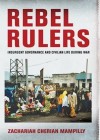Rebel Rulers: Insurgent Governance and Civilian Life During War
Written by: Zachariah Cherion Mampilly,
Cornell University Press, Ithaca and London, 2011,
ISBN 9780801449130, 320pp
Reviewed by: Lieutenant Alexander Ryrie, Australian Army
This is an ambitious book which aims to shed light on the poorly researched subject of insurgent governance during time of war. The central argument of the book is that insurgent governments should be recognised by the international community lest the many civilians who are subject to this government will be neglected by that same international community in what may be a time of dire need. Mampilly argues his case through the analysis of three insurgencies: Sri Lanka’s Liberation Tigers of Tamil Elam (LTTE), the Sudan People’s Liberation Movement/Army (SPLM/A), and the Rassemblement Congolais pour la Democratie-Goma (RCD-Goma). Throughout the book Mampilly investigates the nature and features of insurgent governance. His fieldwork and research describe how contemporary insurgencies have controlled large territories for extended periods of time, establishing extensive governmental structures and practices through which they have ruled major portions of the civilian population.
Through his examination of each insurgency Mampilly identifies the differences in the governance systems developed, and the unique factors that shaped the governance structures within each conflict.
Mampilly’s central argument is that regions that are under the control of insurgent governments are not necessarily anarchic badlands, and that to ensure the welfare of the civilians living within these areas the international community needs to recognise the governance structures and organisations established by the insurgent groups:
By denying the existence of political order within rebel-held areas and refusing to offer a meaningful pathway to recognition based on civilian treatment, the international community is taking a position that essentially abandons large areas of the map, too often to the detriment of civilians living within.
The author goes to great lengths to describe the governance structures established by the insurgents in all three conflict areas; however he spends little time suggesting what the international community should do once it recognises the insurgent government. This lack of analysis of how international recognition would improve the lot of the average civilian living in an insurgent-controlled area is, I believe, a major flaw in this book. Mampilly uses his book to describe a problem but fails to suggest a solution.
While this work is clearly aimed at government policy developers and academics, certain chapters would clearly be of interest to the military commander. It is widely accepted that the population should be the focus of any counterinsurgency campaign. Through understanding how these various insurgencies interacted with the local populations many lessons can be learnt which could be put to use in future campaigns that exhibit similar characteristics to those Mampilly analyses. The author’s most important finding is that each insurgency is unique and shaped by individual external and internal factors which must be understood within the context of the conflict.
Overall, this book is hard work for the amount of knowledge that it imparts to the reader. Written in very academic prose, it is hardly a leisurely read and, as a reference guide, it is not overly useful as the structure is at times chaotic. In saying this it remains an interesting work which is worth reading for the light it sheds on an important subject that is yet to be adequately explored.

